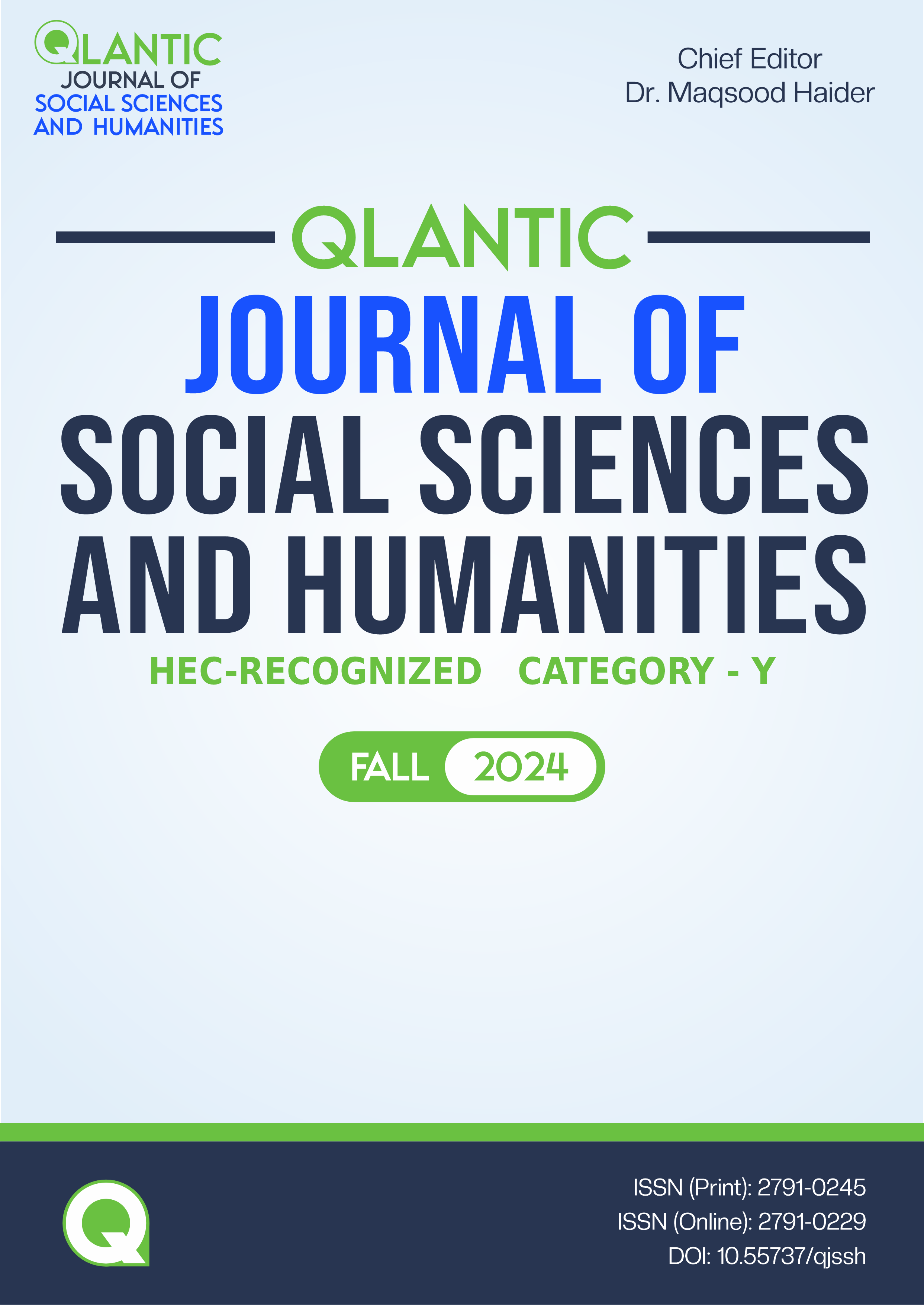Examining the Influence of Pakistani Television Dramas Depicting Extramarital Affairs on Youth
DOI:
https://doi.org/10.55737/qjssh.v-iv.24262Keywords:
Extramarital Affairs, Mean World Syndrome, Infidelity, Media Portrayals, Media LiteracyAbstract
This study has examined the influence of dramas depicting extramarital affairs on Youth, focusing on Pakistani Urdu dramas. The portrayal of extramarital affairs in these dramas has increased in recent years, leading to concerns about their impact on Youths' attitudes and beliefs. The main aim was to examine the level of exposure Youth have to these portrayals, explore the association between exposure and its influence on Youth and investigate the potential cultivated effect of Mean World Syndrome. A quantitative research approach was employed and data was collected through a survey, administered to a randomly selected sample of 347 students from the Foundation University Rawalpindi Campus. The questionnaire demonstrated reliable internal consistency of α= 0.71. The results demonstrated a positive but weak relationship between the amount of exposure to these dramas and the perceived influence they have on Youth. The correlation (r=.25) is weak indicating that greater exposure does not necessarily lead to a greater impact on Youth perceptions of marriage. Negative correlation (r=-.53) was also found between exposure to dramas and development of Mean World Syndrome. This suggests that the greater exposure of Youth does not necessarily lead to mistrust on relationships and may not be significant source of influence.
References
Alanazi, N. (2021). Married Couples’ Perception of the Excessive Use of Social Media and its Impact on Marital Problems in Saudi Arabia. University of Sharjah (UoS) Journal of Humanities and Social Sciences, 18(1A), 61–94. https://doi.org/10.36394/jhss/18/1a/15.
Aleem, Dr. N. (2021). Depiction of black magic in Pakistani dramas and its impact on viewers an analysis with mixed method approach. PalArch’s Journal of Archaeology of Egypt / Egyptology, 18(10). https://archives.palarch.nl/index.php/jae/article/view/10212/9382.
Alexopoulos, C., & Gamble, H. (2022). Prime Time Affairs: A quantitative analysis of infidelity in popular television programs. Sexuality & Culture, 26(4), 1490–1509. https://doi.org/10.1007/s12119-022-09955-9.
Arafat, Y., Sial, N., & Zafar, A. (2020). A Study of Extra Marital Relations in Urdu Dramas: A Qualitative Analysis. Pakistan Journal of Gender Studies, 20(1), 251-271.
Aslam, S., Ali, A., Ullah, F., & Munawar, M. (2015). Socio-Ethical impact of Turkish dramas on educated females of Gujranwala-Pakistan. Journal of Humanities and Social Science, 20(2), 125–131. https://doi.org/10.6084/m9.figshare.1353149.
Bibi, M., Rafique, R., Nazir, A., Zahid, H., Mukhtar, S., & Huda, N. ul. (2024). Perceptions of Married Adults Regarding Extramarital Affairs in Lahore, Pakistan. Human Nature Journal of Social Sciences, 5(2), 334-346. https://hnpublisher.com/ojs/index.php/HNJSS/article/view/517.
Fincham, F. D., & May, R. W. (2017). Media effects on relationship satisfaction and commitment. In J. Mattingly (Ed.), The International Encyclopedia of Media Effects (pp. 1-9). Wiley.
Gerbner, G. (1998). Cultivation Analysis: An Overview. Mass Communication & Society, 1(3–4), 175–194. https://doi.org/10.1080/15205436.1998.9677855.
Hadi, A. (2017). Patriarchy and Gender-Based violence in Pakistan. European Journal of Social Sciences Education and Research, 10(2), 297. https://doi.org/10.26417/ejser.v10i2.p297-304.
Ibrahim, K., Amin, S., & Rehman, H. U. (2020). The portrayal of Women as a Victim in Pakistani Private TV Channels: Perception of Women of Twin Cities of Pakistan. Journal of Peace Development & Communication, 03(02). https://doi.org/10.36968/jpdc-v03-i02-05.
Iqbal, M. S., Batool, D. S., Kausar, D. S., Iqbal, N., & Malik, H. (2022). Social Media And Mean World Syndrome: Effects Of Violent Facebook Posts On Women. Journal of Positive School Psychology, 407–428. https://journalppw.com/index.php/jpsp/article/view/14742
Kaur, M. (2012). Media and Violence in Youth: A Study in the context of the ‘Mean World Syndrome.’ International Journal of Psychology and Counseling, 2(1), 31. https://doi.org/10.37622/ijpc/2.1.2012.31-36.
Kemp, S. (2023). It’s a mean, mean world: social media and mean world syndrome. https://doi.org/10.15760/honors.1333.
Masood, M. (2024). Marital Life and TV dramas: depiction and influence on perceptions of married and unmarried audience [Master’s Thesis, Charles University]. https://dspace.cuni.cz/bitstream/handle/20.500.11956/192061/120476395.pdf?sequence=1.
Muneer, S., & Munir, S. (2020). impact of TV content on audience’ perception of materialism. International Journal of Linguistics Literature and Culture, 6(4), 62–75. https://doi.org/10.21744/ijllc.v6n4.906.
Nielsen. (2019). TV streaming across our cities (Nielsen Local Watch Report, pp. 1–25). https://www.nielsen.com/insights/2019/the-nielsen-total-audience-report-september-2019/.
Pollock, W., Tapia, N. D., & Sibila, D. (2021). Cultivation theory: The impact of crime media’s portrayal of race on the desire to become a U.S. police officer. International Journal of Police Science & Management, 24(1), 42–52. https://doi.org/10.1177/14613557211036555.
Rehman Warrich, Dr. H. U., Shehzad, M., & Waheed, Dr. S. (2021). Impact Of Pakistani TV Dramas On The Social Values Of Pakistan. Webology, 18(4). https://webology.org/data-cms/articles/20220415110913pmwebology%2018%20(4)%20-%20124%20pdf.pdf
Reizer, A., & Hetsroni, A. (2014). Media exposure and romantic relationship quality: a slippery slope? Psychological Reports, 114(1), 231–249. https://doi.org/10.2466/21.07.pr0.114k11w6.
Shahbaz, N, Shafiq, M., Zaman, K., & Maqsood, M. (2015). Impact of Turkish dramas on Pakistani female viewers: a case study of Bahria University students. Journal of Media Studies, 30(1), 57–69.
Siddique, S. (2016, April 13). No means yes Pakistan TV s dangerous trend of celebrating rapists and stalkers as heroes. The Express Tribune. https://tribune.com.pk/story/1082725/no-means-yes-pakistan-tvs-dangerous-trend-of-celebrating-rapists-and-stalkers-as-heroes.
Slater, M. D. (2004). Operationalizing and Analyzing exposure: The foundation of Media Effects research. Journalism & Mass Communication Quarterly, 81(1), 168–183. https://doi.org/10.1177/107769900408100112.
Vandenbosch, L., & Eggermont, S. (2012). Understanding Sexual Objectification: a comprehensive approach toward media exposure and girls’ internalization of beauty ideals, Self-Objectification, and body surveillance. Journal of Communication, 62(5), 869–887. https://doi.org/10.1111/j.1460-2466.2012.01667.x.
Yasin, B., & Khan, F. R. K. (2022, August 2). Analysis of Social Reality of Spousal Relationship Depicted in Pakistan Television Prime time Dramas. http://ojs.sbbwu.edu.pk/fwu-journal/index.php/ojss/article/view/965.
Downloads
Published
Issue
Section
License

This work is licensed under a Creative Commons Attribution-NonCommercial 4.0 International License.





